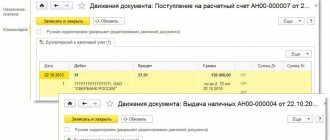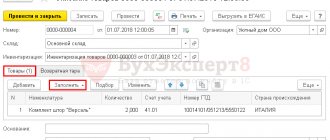Accounting is the theory and practice of bookkeeping and accounting. It is used in all organizations and enterprises and serves to accumulate data on all business transactions, property status and obligations of a legal entity to counterparties and regulatory authorities. Accounting involves the use of special numbers for each type of incoming and outgoing transactions.
Among them there is also a register that allows you to control current accounts. This is 51 accounting accounts. In this material, especially for dummies, we will examine in detail what account 51 is, whether it is active or passive, what the account card 51 looks like, what it is and with which registers it corresponds.
Accounting is based on recording all transactions in special positions
What it is
Settlements with suppliers of goods or raw materials, customers of these goods or personnel are one of the most important transactions in the life of every legal entity. 51 accounts in the accounting department is the “Settlement Accounts” register, designed to collect information about the availability of material assets in the national currency of the Russian Federation (in Russian rubles) and about their movement through the payment accounts of an organization or enterprise. Accounts, in turn, must be opened in financial and credit institutions. Register 51 is active, since the opening and closing balances for it can only be debit
Position 51 reflects the movement of all funds in current accounts
Reflection of the cashless system in accounting
For analysis, planning, accounting, and transfer of non-cash payments, the enterprise opens a synthetic, balance sheet accounting account 51. It is active, which means that incoming funds are reflected as debits, and expenditures of financial resources are reflected as credits. 51 accounts were created to account for the most mobile of the company’s assets – non-cash funds. It is reflected in the balance sheet in a generalized form; the balance is determined daily for the prompt management of finances. Analytical accounting is carried out for each item of receipt and expense separately. An organization can simultaneously open the required number of accounts in one or more credit institutions. Regardless of their number, all information on non-cash transactions is summarized and posted to 51 accounts. The balance (remainder) is formed according to the formula: balance at the beginning + turnover on the debit of the account – turnover on the loan. The result obtained is the amount of funds available (currently). It is applied to account 51 as the opening debit balance for the next period.
What is it used for?
Account 51 was created in order to keep records, control and analyze data on the material funds of a legal entity that are located in banking organizations. This register reflects only payment and acceptance in the national currency of Russia.
Cash received by 51 registers will be accounted for as a Debit, and the amounts of all write-offs will be recorded as a Credit, which is obvious. One of the grounds for displaying receipts from this account is bank statements, and the amounts of all money transfers are carried out on the basis of instructions to make a payment.
Important! Analytical accounting for 51 accounts is carried out in the context of individual suppliers and customers who perform payment and receipt transactions with the company, as well as in the context of types of operations, for example, settlements with counterparties, payment of wages to personnel or payment of debt.
It is better to carry out analytics by dividing into counterparties and types of operations
Types of calculations
In practice, two main types of payments are used - cash and non-cash. Cash, as a rule, is used for small volumes of cash flow - these are one-time payments that can be made through the company's cash desk. For small businesses with low turnover and modest income, using cash is the best option. Large companies are more likely to adopt a cashless system; as the results of its use have shown, it is much more effective, faster and cheaper than working with large amounts of money. Therefore, today 98% of all payments are carried out through the banking system, on a non-cash basis.
Account characteristics
The debit (Dt) of the account reflects the receipt of funds to the organization's current accounts in the banks in which it is a client. That is, all money that was credited to the name of a legal entity passes through Debit 51 of the register. It is worth remembering that for a financial institution these funds are credit funds, therefore they will be located in the “Credit” item on the statement.
Examples of basic receipt operations:
- Receipt of funds from the buyer Dt 51.01, Kt 62.01 Bank statement or client payment order (primary document);
- Crediting collection revenue Dt 51.01, Kt 57.01. Bank statement or transmittal statement;
- Receipt of money under a loan or credit Dt 51.01, Kt 66 Bank statement, loan agreement, loan agreement;
- Contribution of the founder of a legal entity Dt 51.01, Kt 75.01 Bank statement or bank order.
The operation diagram of register 51
Credit (Kt) also shows the debiting of money from the organization’s bank accounts. It displays all transactions in descending order of funds.
Posting examples:
- Receipt of funds in cash, Dt 50.01 Kt 51.01, Bank statement or check for cash;
- Payment to the counterparty for goods or services, Dt 60.01 Kt 51.01, Bank statement, payment order;
- Repayment of borrowed funds, Dt 66 Kt 51.01, Bank statement or loan agreement;
- Transfer of salaries to staff on a card, Dt 76.05 Kt 51.01, Bank statement, letter for refund.
Loan movement
The credit of account 51 is formed from write-off (expense) transactions of non-cash funds of the enterprise. The loan turnover shows the total amount of transfers, write-offs and cash withdrawals deposited into account 51. The loan entries are as follows:
- Cash withdrawal (D 50, K 51) - funds are withdrawn from the current account and received at the enterprise's cash desk (cash out occurs on a limited basis, indicating the expense item). Most often, organizations use part of the funds to pay salaries or for business needs.
- Transfer of non-cash funds (D 51/55, K 51) - this correspondence is carried out when transferring part of the funds to another account or opening special letters of credit intended for settlements with counterparties.
- Payment to suppliers, contractors and other creditors (D 60/62/76, K 51) - transfer of the amount of assets from the current account to counterparties (for goods and services, product returns, etc.).
- Calculations for loans, advances and credits (D 66, K 51) - interest on the use of borrowed funds is listed or the debt on loans is repaid.
- Fulfillment of obligations to budgets of various levels and extra-budgetary funds (D 68/69, K 51) - depending on the tax or fund, the corresponding sub-accounts are indicated in correspondence.
- Salary (D 70, K 51) - transferred salary to employees.
- Settlements with founders (D 75, K 51) - based on the results of activities, payments were made to the founders.
Existing subaccounts
There are no official sub-accounts for 51 items. In accounting software like 1C: Enterprise or 1C: Accounting, you can create your own sub-accounts and even accounts. This is often used, but mistakes also happen often. By adding 51.01, 51.02 and other subaccounts, you can find that the ending balance for Debit and Credit will be the same at the end of one month, and then will be different.
Many people are accustomed to adding subaccounts to simplify work or to separate costs and profits for different types of activities. In new versions of 1C: Accounting 8, adding subaccounts may not end in the best way.
Important! Problems especially often appear at the end of the month, when it needs to be closed. The amounts in the subaccounts simply freeze, which requires additional modifications and procedures for closing the month.
The desire to add your own subaccounts and accounts in new versions of 1C may end badly
Typical postings and examples of operations
The correspondence of accounts for account 51 “Current accounts” is presented in the table:
Get 267 video lessons on 1C for free:
- Free video tutorial on 1C Accounting 8.3 and 8.2;
- Tutorial on the new version of 1C ZUP 3.0;
- Good course on 1C Trade Management 11.
| Account Dt | Kt account | Operation description |
| 51 | 57 | Funds “on the way” arrived in the account |
| 51 | 58/66,67 | Repayment of the loan provided/receipt from the loan taken and other loans |
| 51 | 86 | Receipt of funds for targeted funding, from other organizations and individuals, the budget |
| 51 | 91 | Sales revenue |
| 81 | 51 | Redemption of shares (own shares) from participants |
| 84 | 51 | Payment for events (by decision of the founders) |
| 99 | 51 | Coverage of uncompensated expenses related to emergencies and natural disasters |
Correspondence with other accounts
Register 51 corresponds with other accounts for Debit and Credit. List of interactions by Debit:
- 50 - Cash desk;
- 51 — Settlement registers;
- 52 — Currency registers;
- 55 – Special bank accounts;
- 57 — Transfers on the way;
- 58 - Financial investments;
- 60 — Settlements with suppliers and contractors;
- 62 — Settlements with buyers and customers;
- 66 — Calculations for short-term loans and borrowings;
- 67 — Calculations for long-term loans and borrowings;
- 68 — Calculations for taxes and fees;
- 69 — Calculations for social insurance and security;
- 71 - Settlements with accountable persons;
- 73 — Settlements with personnel for other operations;
- 75 — Settlements with founders;
- 76 - Settlements with various debtors and creditors;
- 79 — On-farm calculations;
- 80 — Authorized capital;
- 86 - Targeted financing;
- 90 - Sales;
- 91 — Other income and expenses;
- 98 - Deferred income;
- 99 - Profits and losses.
The current account position corresponds with a large number of other accounting positions for debit and credit.
Correspondence regarding the Loan occurs with:
- 04 - Intangible assets;
- 50 - Cashier;
- 51 — Current accounts;
- 52 — Foreign currency accounts;
- 55 – Special bank accounts;
- 57 — Transfers on the way;
- 58 — Financial investments;
- 60 — Settlements with suppliers and contractors;
- 62 — Settlements with buyers and customers;
- 66 — Settlements on short-term loans and borrowings;
- 67 — Settlements on long-term loans and borrowings;
- 68 – Payment of taxes and fees;
- 69 — Calculations for social insurance and security;
- 70 — Remuneration of personnel;
- 71 — Settlements with accountable persons;
- 73 — Settlements with personnel for other operations;
- 75 — Settlements with founders;
- 76 – Payment to various debtors and creditors;
- 79 — Intra-economic calculations;
- 80 — Authorized capital;
- 81 — Own shares (shares);
- 84 — Retained earnings (uncovered loss);
- 96 — Reserves for future expenses;
- 99 - Profit and loss.
Register analysis table for the accounting period in the 1C: Accounting program
Types of non-cash payments
All settlement and payment transactions are carried out by the bank with which the organization has entered into an agreement for servicing the account. The basis for carrying out operations with the withdrawal or transfer of funds is a written notification of the owner, which is checked by bank employees for compliance with legal norms and unified forms. The organization that owns the funds chooses the form of non-cash payment independently, based on the contractual obligations of specific counterparties. Most often, the paying company, using the appropriate document, gives the bank an order to withdraw (write off, transfer) non-cash funds from the account in favor of the specified counterparty. Less common are unconditional write-offs, the confirmation of which is not required from the owner of the assets. Cash withdrawals for own needs are carried out by the organization using checks. Bank account holders receive the required check limit based on the application. Checkbook sheets filled out and certified with appropriate signatures and seals can also be used for settlements between the account holder company and contractor organizations, suppliers, etc. In this case, the check is issued to the organization or individual (its representative) and is cashed upon presentation at the bank payer.
Accounting entries
The main item of transactions that can be carried out under 51 items are settlements with counterparties, who are suppliers of goods or raw materials, customers when performing services, and buyers. All these actions are carried out in accordance with previously concluded agreements. Typical transactions for such operations are as follows:
- Debit 51 Credit 62 - Receipt of funds from customers for goods or services (both as an advance payment and as a full final payment);
- Debit 51 Credit 60 - Returns by suppliers of goods or services before they are paid for;
- Debit 51 Credit 43 - Receipt of money for the provision of goods transportation services;
- Debit 51 Credit 76 - Receipt of money under concluded agreements with counterparties;
- Debit 60 Credit 51 - Payment to suppliers or contractors for services, goods or work rendered, both in the form of an advance payment and in the form of final payment;
- Debit 62 Credit 51 - Return to customers or buyers of funds that were credited by mistake earlier;
- Debit 76 Credit 51 - Accrual of money to other organizations and persons for other types of transactions;
- Debit 51 Credit 90 - Receiving revenue from the sale of products or performance of work (rendering services);
- Debit 51 Credit 91 - Receiving income from sales and other disposals, as well as reflecting non-operating income.
Important! Account assignments about changes in the state of accounted objects, described above, are not comprehensive for 51 registers, since it corresponds with a large number of positions, both for Debit and Credit. More wiring can be done.
Form of the Turnover balance sheet for 51 registers
Account Analysis
The analytics process involves deciphering the turnover and balance in the context of financial institutions for all of the accounts opened with them. Most often, in accounting and accounting systems, analytical accounting for 51 accounts is organized in the form of the following reports:
- The balance sheet for this register;
- Account Analysis 51;
- Account card 51.
Thanks to the formation of these documents, it is possible to control the movement of material assets at least every day and realize the possibilities for disposing of assets within the framework of the final balance. The analysis represents the correct formation of the balance at the end of the reporting period of any length. To calculate the balance, you need to add up the opening balance and debit turnover, and then subtract from this the total volume of cash movements on the loan in a given reporting period.
The balance sheet of register 51 is the balance for this register, which is displayed at the end of the month to close it. It should contain the beginning and ending balances, the total amounts of turnover for Dt and Kt. Also, SALT 51 is formed on the basis of a section of subaccounts.
Sample analysis card for 51 accounts, which is filled in automatically
Thus, 51 accounting registers are an accounting position that summarizes data on settlements of a legal entity with counterparties, customers and employees. It reflects the receipt of money into the organization’s accounts under Debit and its write-off under Credit. To analyze it, there is a card and OSV 51, which can provide the necessary data on a monthly basis.
https://www.youtube.com/watch?v=h5Q2PfrU45k









